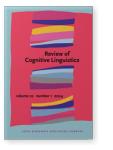Vol. 22:1 (2024) ► pp.124–150
Gradience in iconicity
Evidence from total reduplicative constructions in Nigerian Pidgin
While it has largely been taken for granted by most linguists that the relationship between linguistic signifier and signified is arbitrary in nature, a growing number of studies suggest otherwise. In this article, we demonstrate that iconicity in total reduplicative constructions in Nigerian Pidgin is graded in nature, and that the degree of iconicity of any given reduplicative is largely correlated with the word class to which its simplex form belongs, with reduplicated ideophones and adverbials exhibiting the highest degree of iconicity, reduplicated pronouns the lowest degree of iconicity, and reduplicated adjectives, nouns, numerals and verbs intermediate degrees of iconicity.
Our results shed light, not only on which word classes are more prototypically involved in reduplication than others in the world’s languages, but also on typical pathways that reduplicatives follow in processes of grammaticalization, whereby their isomorphic form-meaning relationship appears increasingly attenuated, albeit due to varying language-internal factors that are specific to individual languages.
Article outline
- 1.Introduction
- 2.Iconicity
- 3.Total reduplication and related phenomena
- 3.1Frozen reduplication
- 3.2Stylistic repetition
- 4.Total reduplication in Nigerian Pidgin
- 5.Deviations from prototypically isomorphic iconicity related to total reduplication in Nigerian Pidgin
- 5.1Reduplication of pronouns
- 5.2Reduplication of verbs
- 5.3Other isolated cases of non-iconic reduplication
- 6.Discussion and conclusion
- Acknowledgements
- Notes
- The abbreviations used in the glosses for the examples in this work include the following
-
References
